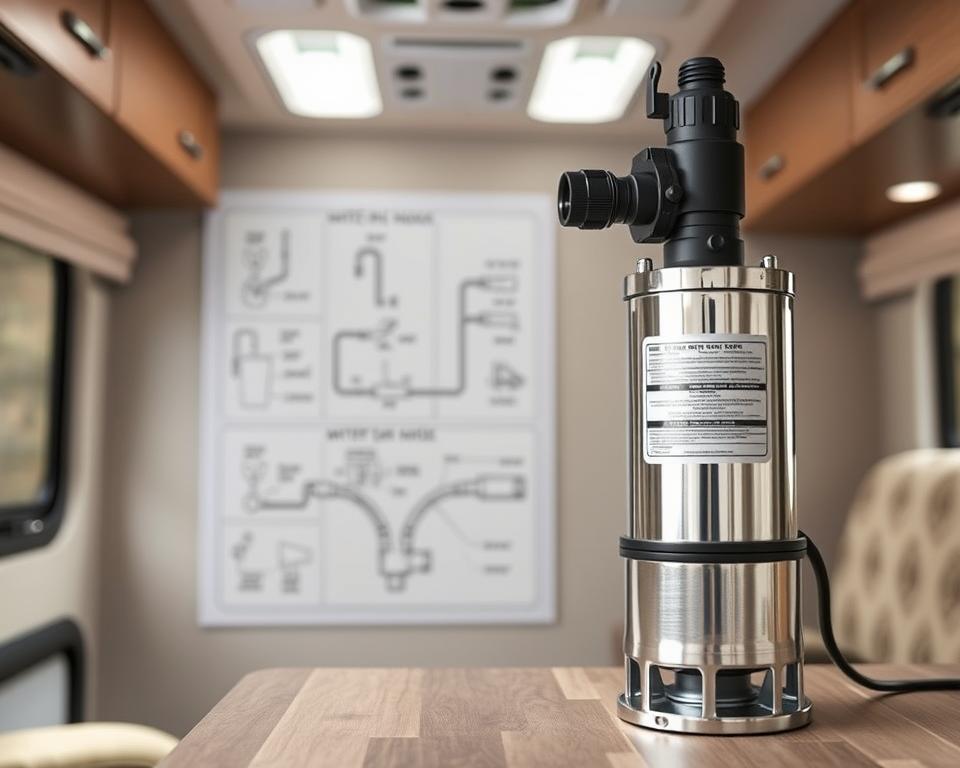Septic Aerator Unit: Comprehensive Guide for Property Owners
Curious about what powers your aerobic septic system’s performance? The air unit in your Septic system is the unsung key component vital for your system. In this article, readers will acquire valuable knowledge on the aerator’s role. It’s necessary for a sound, optimized Septic tank.
Knowing the importance of a Septic tank air Pump can optimize your Septic system’s operation using RV septic removal. It also preserves your home equity and environmental health. The resource below will introduce All in Sanitation, a leading Septic industry specialist. They’re prepared to serve your Septic aerator Pump needs.
Noteworthy Points
- The Septic air Pump is crucial for aerobic Septic systems.
- Properly caring for your Septic system air Pump can enhance overall system performance.
- Routine inspections extend the service life of your Septic tank air Pump.
- Selecting the correct Septic aerator Pump is critical for peak operation.
- All in Sanitation offers tailored services for Septic air Pump requirements.
Understanding Aerobic Septic Setups
Aerobic Septic systems offer a more effective waste treatment approach by using oxygen. This process consists of aerobic bacteria living in well-oxygenated environments. These bacteria are more efficient in decomposing organic matter. With the help of Septic aerator Pumps, these systems provide a steady oxygen supply, improving the waste decomposition process.
These systems excel in minimizing sludge buildup, owing to the efficiency of aerobic bacteria. This reduction in solid waste means fewer service calls and tank Pump-outs is necessary. Additionally, they effectively manage wastewater, leading to minimal smells. This creates a improved environment for homeowners and the community as a whole.
To ensure these systems operate efficiently, it’s essential to know the key Septic system components. These include the Septic tank, oxygenation chamber, and effluent Pump. Each component serves a key function, especially the air Pump. It drives oxygen into the tank, vital for the aerobic bacteria’s efficiency.
Role of the Septic Air Pump
The Septic air Pump is pivotal in the performance of aerobic Septic systems. It serves as the system’s “lungs,” pushing the vital oxygen required. This oxygen allows aerobic bacteria to thrive and decompose waste efficiently. If the Pump stops, the system’s capability decreases, resulting in sludge buildup and possible odors.
Such issues can disrupt Septic system operations and cause environmental hazards. By realizing how critical the Septic air Pump is, homeowners can respond ahead of time. They can ensure its best function through regular maintenance. This stops failures, sidesteps costly repairs, and maintains the aerobic system’s integrity.
Top Advantages of Using a Septic Air Pump
Employing a Septic air Pump significantly boosts the efficiency of Septic systems. Septic air Pumps are key as they speed up the breakdown of waste. This is realized by oxygenating the treatment process, supporting aerobic bacteria growth. These bacteria are vital for effective waste treatment.
They’re also important in reducing foul smells. Due to more active aerobic processes, waste decomposes faster, thus reducing odors. This ensures better surroundings for homeowners.
Another valuable benefit is the decrease in sludge buildup. Consequently, tanks necessitate less frequent Pumping, reducing both money and time. Greater processing not only lowers bills but also prolongs the lifespan of the drain field.
Looking after these Pumps diligently means fewer repair costs and complying with regulatory standards. Thus, the upsides of Septic air Pumps go beyond being for homeowners. They also support environmental health by advancing waste management practices.
| Benefit | Description |
|---|---|
| Fast Waste Breakdown | Heightened aerobic activity hastens the decomposition process. |
| Minimized Odor Emissions | Better treatment efficacy creates fewer odors. |
| Reduced Sludge Buildup | Less frequent Pumping and maintenance are called for. |
| Extended Drain Field Life | Better treatment equals a healthier drain field. |
| Cost Savings | Lower probability of repairs and regulatory compliance cost. |

Choosing the Right Septic Air Pump
Choosing the correct Septic air Pump is essential for an optimized aerobic system. Homeowners ought to review various factors for the best fit. The size of the tank and the airflow requirements are important the Pump’s effectiveness.
To choose intelligently, it’s useful to be aware of the air Pumps available. There are mainly two types: linear diaphragm Pumps and rotary vane Pumps. Each comes with specific strengths, which should be suited with your home’s individual circumstances and how it operates.
Energy efficiency also deserves attention. Picking a Pump that minimizes energy use while supplying the needed airflow can yield significant savings. Assistance from All in Sanitation experts can be extremely useful. They make certain the Pump you choose matches your system’s requirements precisely.
Common Types of Septic Air Pumps
Homeowners can make better choices by understanding the distinct Septic air Pumps available. There are mainly two types: diaphragm Pumps and rotary vane Pumps. Each has its individual functions and benefits.
Diaphragm Pumps, known for their hushed operation, are preferred for residential Septic systems. They provide energy efficiency while ensuring stable air output. Their trustworthy performance suits smaller systems, appealing to many homeowners.
Rotary vane Pumps, however, are ideal for higher-capacity or commercial systems. These Pumps deliver more power, necessary for handling bigger loads. Their strong build allows efficient operation in heavy-duty Septic systems.
| Type of Pump | Best Use | Advantages |
|---|---|---|
| Diaphragm Pumps | Residential Systems | Quiet operation, energy-efficient, reliable air flow |
| Rotary Vane Pumps | Larger or Commercial Systems | Powerful performance, high capacity, durable construction |
Recognizing the distinctions in Septic air Pumps is vital for upgrades or replacements. Each Pump type provides unique qualities to meet various needs. This guarantees optimal performance for any system.
Indicators You Require a Septic Air Pump Replacement
Homeowners must be alert to Pump failure signs in their Septic systems. Some signals indicate the need for a Septic air Pump replacement. These keep the system running smoothly. Identifying these quickly avoids serious issues.
Signs of potential problems include:
- Unusual noises from the Pump, like scraping or vibrating, might signal internal damage.
- A clear lack of air output indicates the Pump isn’t operating efficiently, affecting efficiency.
- Repeated electrical problems, such as blown fuses or voltage drops, could indicate overloading.
- Visible damage on the Pump unit, with breaks or leaks, calls for quick action.
- Bad smells in the yard often indicate a compromised Pump, highlighting ineffective effluent aeration.
Detecting these signs early prevents costly fixes or total system failure. Carrying out regular checks helps spot these issues. It also demonstrates if you require a new Septic air Pump.
Care Guidelines for Your Septic Air Pump
For an effective Septic air Pump, regular maintenance is essential. This ensures that that your system functions properly. Homeowners can apply several straightforward care strategies for optimal results.
Bi-annually, run a careful inspection for wear or damage. It is also important to swap out the filters as recommended. This reduces clogs that could hurt efficiency.
The Pump should sit on a solid base to cut vibrations, which could affect it over time. A protective cover is vital too. It guards against debris and water, keeping the Pump’s functionality.
Proper maintenance can considerably extend the life of your Pump. In turn, this enhances the Septic system’s performance as a whole.
| Maintenance Task | Frequency | Benefits |
|---|---|---|
| Inspect Pump for damage | Every 6 months | Identifies issues early |
| Replace filters | As needed | Improves efficiency |
| Check surface stability | Annually | Minimizes shake |
| Clear debris around Pump | Monthly | Stops blockages |
Setting Up Your Septic Air Pump
Proper installation of your Septic air Pump is key for its efficient operation. To start, choose a safe, moisture-free area for placement. The chosen spot should reliably hold the Pump’s weight without strain.
To reliably mount your Pump on your own, use the following guidelines:
- Prepare all necessary items, including the Pump, a power source, and hose fittings.
- Carefully read the manufacturer’s guidelines before kicking off your installation.
- Verify every connection is sealed to avoid air leaks that compromise performance.
- After assembly, conduct a test to check the system works as intended.
If the installation process feels tricky, reach out to All in Sanitation. Their professionals can circumvent common errors, ensuring your setup adheres to relevant safety requirements.
Why Choose All in Sanitation for Your Septic Air Pump Requirements
When deciding on a Septic service provider, the choice is significant. All in Sanitation sets itself by offering dependable Septic air Pumps. They satisfy varied homeowner requirements with a comprehensive selection of premium products. This guarantees customers secure an ideal match for their Septic systems.
What really sets apart All in Sanitation is more than their extensive product lineup. Their commitment to outstanding customer service is equally significant. Homeowners receive expert advice, leading them to trusted Septic solutions. This partnership is essential to adapt each solution to fulfil specific needs.
All in Sanitation also emphasizes aftercare to guarantee lasting satisfaction. Their devotion reaches beyond the initial sale. They deliver ongoing support to keep Septic systems running smoothly for the years ahead.
Financial Aspects for Septic Air Pumps
Knowing the price factors connected with Septic air Pumps is vital for homeowners who run aerobic Septic systems. To start, one faces the buy-in cost, which includes the Pump and needed accessories. Installation expenses change, according to the system’s complexity and any changes required.
Ongoing upkeep forms an additional cost layer. Periodic reviews can prevent bigger issues, eventually resulting in savings. Homeowners should plan for Septic maintenance to keep the Pump’s effectiveness and durability. Such planning sidesteps expensive repairs later on, illustrating the advantage of proactive maintenance.
| Cost Component | Average Cost Range |
|---|---|
| Septic Air Pump | $500 – $1,200 |
| Installation | $300 – $800 |
| Annual Maintenance | $150 – $400 |
| Potential Repair Costs | $1,000 – $5,000 |
Breaking down Septic air Pump expenses into individual parts assists homeowners in budget planning. This detailed approach guarantees the system’s smooth operation and their comfort.
The Final Word
For homeowners with aerobic Septic systems, servicing Septic units is vital. The right Septic air Pump boosts waste processing and increases your system’s life. Scheduling ongoing care and immediately resolving issues prevents high expenses and disruptions.
Picking a Septic air Pump warrants careful thought. This guide highlighted how to choose wisely about installation and replacement. With All in Sanitation’s support, you can navigate your Septic systems’ complexities securely.
Taking care of your Septic air Pump promotes your system’s operation and durability. It provides a trouble-free and effective operation over time. Don’t forget, your home’s wastewater management benefits greatly from consistent upkeep.


